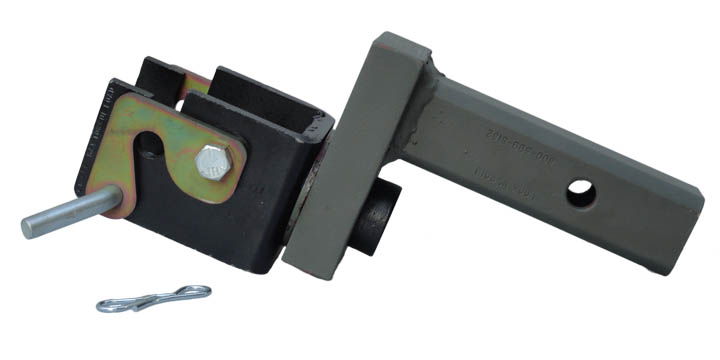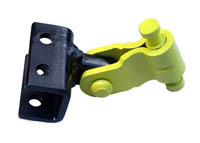FAQs
Q: What’s the weight limit to this hitch?
A: Lock ‘N’ Roll is rated at 11,000 pounds gross trailer weight and 1100 pounds tongue weight. All units exceed the requirements of SAE standard J684 and are tested by independent labs.
Q: Why is this better than a pintle hitch?
A: Lock N Roll has a tight fitting connection that doesn’t have the thunk and jerk and noise the pintle has. This creates a smoother quieter ride and less stress on vehicle and trailer.
Lock ‘N’ Roll has very responsive handling so turns are safer and backing up is easier.
Q: What size the steel tubing needs to be to mount up to your product?
A: Many of the people building off road campers use 2 inch ID x 2-1/2 inch OD square tubing for the trailer tongues.
Q: Do you have a lock for your hitch system?
Is there a way to lock my Lock N Roll? Look online for Infiniterule. They have a 1/2 inch diameter lock that is long enough to replace the lock n roll hitch pin and they have a 5/8 diameter lock for the receiver tube that can be keyed alike.1/2 in. x 4-1/8 in. Span – Stainless Steel Locking Pin | InfiniteRule Security
There is a clamshell style lock that fits over the front of the trailer side lock n roll at Lock-n-Stop
You can also buy high strength chain by the foot on the Lock N Roll website.
https://locknroll.com/shop-now/general/?product_id=46
Use a high strength lock like one used for cargo containers or a European grade 8-10.
Q: How is it when backing up?
A: Great! The 360 degree rotation, along with the left to right and up and down articulation allows fantastic maneuverability, especially when backing a trailer around a corner and into a tight spot.
Q: Do you ship to Canada?
A: Yes we do. Depending on the total weight you can expect to pay $60 to $120 in shipping for a set of Lock N Roll Hitches. If you use a shipping service where it is possible to pick up south of the border that will be much less expensive. Call Greg Russell at 773-277-2802 to place an order. Shipments over 250 pounds will ship via R&L Carriers.
Q: Do you offer OEM discounts?
A: Yes. Call or e-mail us for more information. 773-277-2802 or greg@lawndaleforge.com
Q: Did the grease port get broken off during shipping?
A: No. The grease fitting is a low profile type that requires the use of a needle filler or flush nozzle that can be found at most auto parts stores. We found that the common zerks fittings are easily broken off during use. A nozzle that can be attached to most grease guns is for sale under ‘Other Products’. It is an Alemite brand Z737 Flush Nozzle. Flush Nozzle Grease Fitting | Lock N Roll
Q: Can I reverse the hitch and coupler so the trailer side is on the vehicle and the vehicle portion of the hitch is on the trailer?
A: No, the trailer side and vehicle sides must not be reversed. It will negatively affect a couple of things. First, it will make hitching and unhitching your trailer difficult. Second and more importantly, the hitch and coupler could bind up if you make a very sharp turn or jack knife the trailer while backing up. If the vehicle and trailer sides are reversed the trailer tongue can drop down when the trailer is at a right angle to the vehicle. Since there are no forces to raise the tongue back up the hitch and coupler will bind up and get twisted and distorted when you pull forward. This will not happen if the Lock ‘N’ Roll hitch and coupler are installed correctly.
Q: Do you offer a bolt on version of your part number 504?
A: YES. TS540 comes with pre-drilled bolt holes. PN504 can be bolted on but you will need to drill your own holes. It is impossible to predetermine the location of holes on existing trailer tongues because the slightest difference in width would misalign them. For aluminum trailers a combination of vertical and horizontal bolts is recommended.
Q: How do I replace my existing A-frame ball coupler with Lock N Roll PN504?
A: There are a couple of options. Both start with cutting off the front portion of the ball hitch back to where the trailer frame begins. A reciprocating saw (Sawzall) works well for this. Next you can either grind out the welds and completely remove the old coupler or mount the lock n roll PN504 over the top of the old coupler. If you remove the whole thing, saw cut all the way down the center so that the pieces are easy to work loose as you carefully grind away the welds.
If the old coupler is solidly welded on and you are able to align the jack stand holes you could weld the lock n roll over the top of the old coupler. It is also possible to install PN504 with the legs pointing upwards instead of how 50-degree brackets are usually mounted. One advantage of doing this is there will be opportunities for down hand welds.
Q: How high should a trailer tongue be?
A: ISO 10061 puts the center of effort at 430 +/- 35mm
Q: How tight should the bolts be? What are the torque values?
A: The bolt that attaches the T-shape to the trailer should be torqued to 180-220 ft lbs. The two bolts for the height adjustment channels should be tightened until they start to close in the channel. The 1/2″ bolt that holds the latch plates should be loose with about 1/16 to 1/8″ gap. Make sure the nut is a prevailing torque nut with either a deformed nut or a nylon insert.
Q: For the combination of PN505 and PN502, what is the distance between the center of the ⅝” receiver pin and PN502?
A: There are two 16mm holes in the 2″ tube on PN505 and PN515. (A 16mm hole provides just the right amount of clearance for a ⅝” bolt or pin.) The distances from the centers of those holes to the center of the coupling shaft on PN502 are 14-1/4 and 16-1/4 inches respectively. The distances from the 16mm holes in the 2” tube to the back of the channel that faces the vehicle are 7-3/4 and 5-3/4 inches.
Q: It’s hard to rotate my new Lock N Roll. Is it defective?
A: The hitch will rotate under load and will work free. The hitch is assembled by hot riveting. We try to make the fit as tight as possible initially with the expectation that it will loosen up after some use and the paint is worked free.



